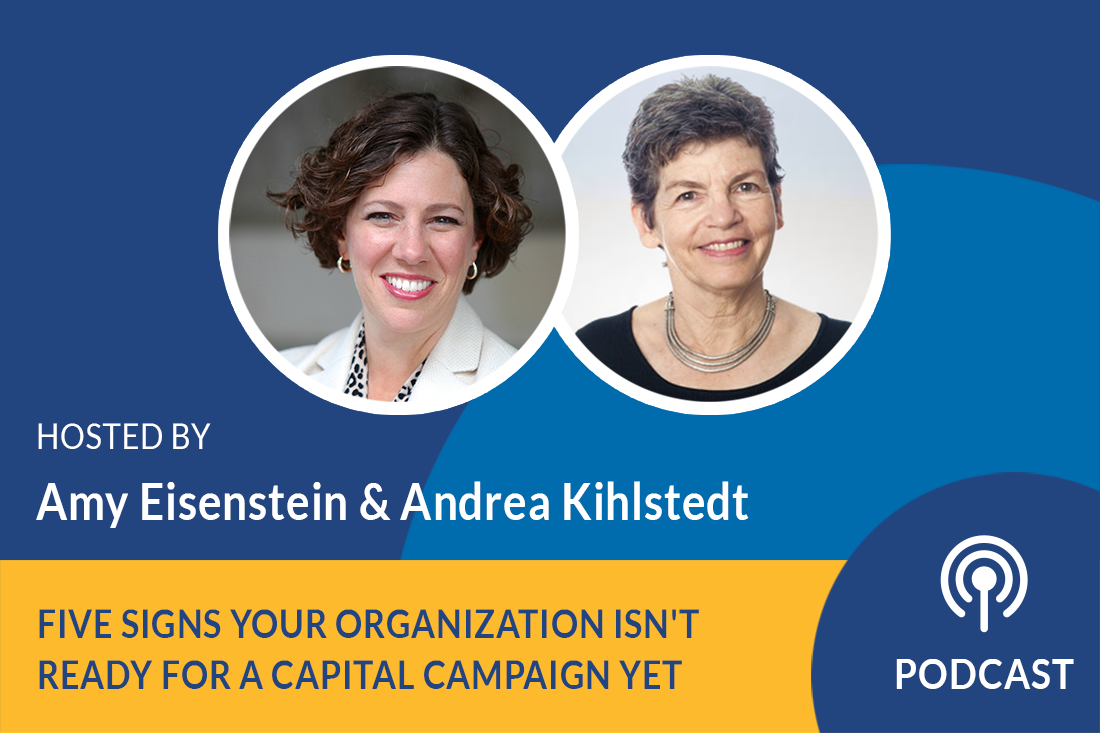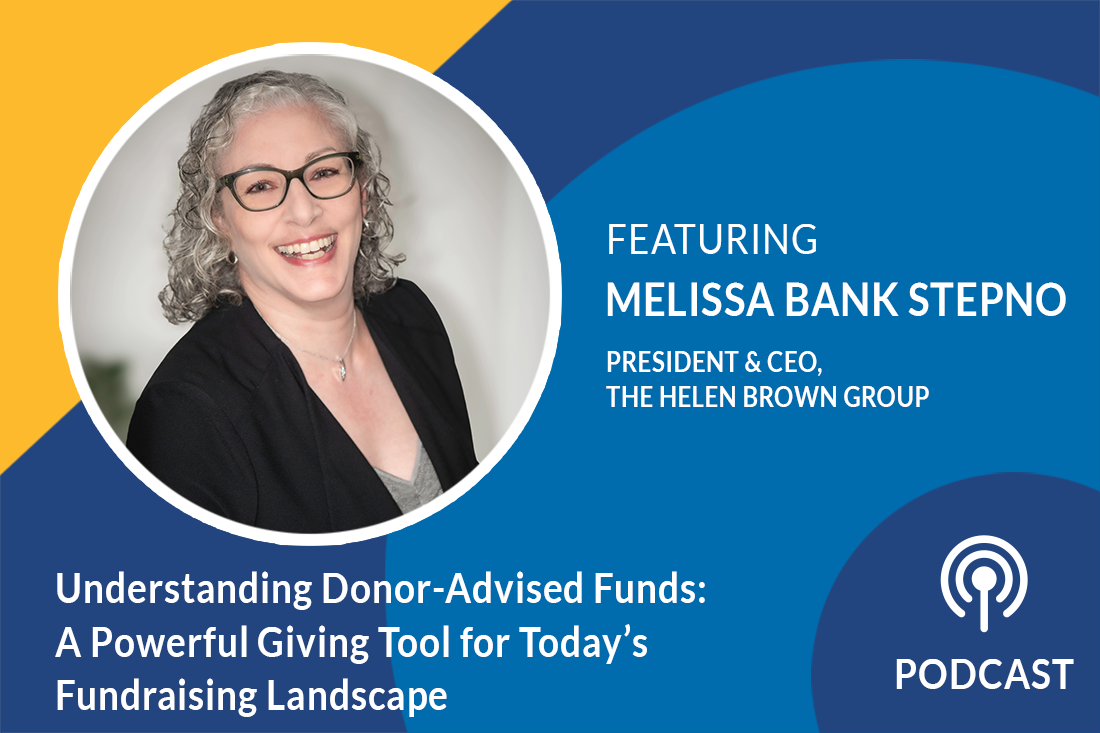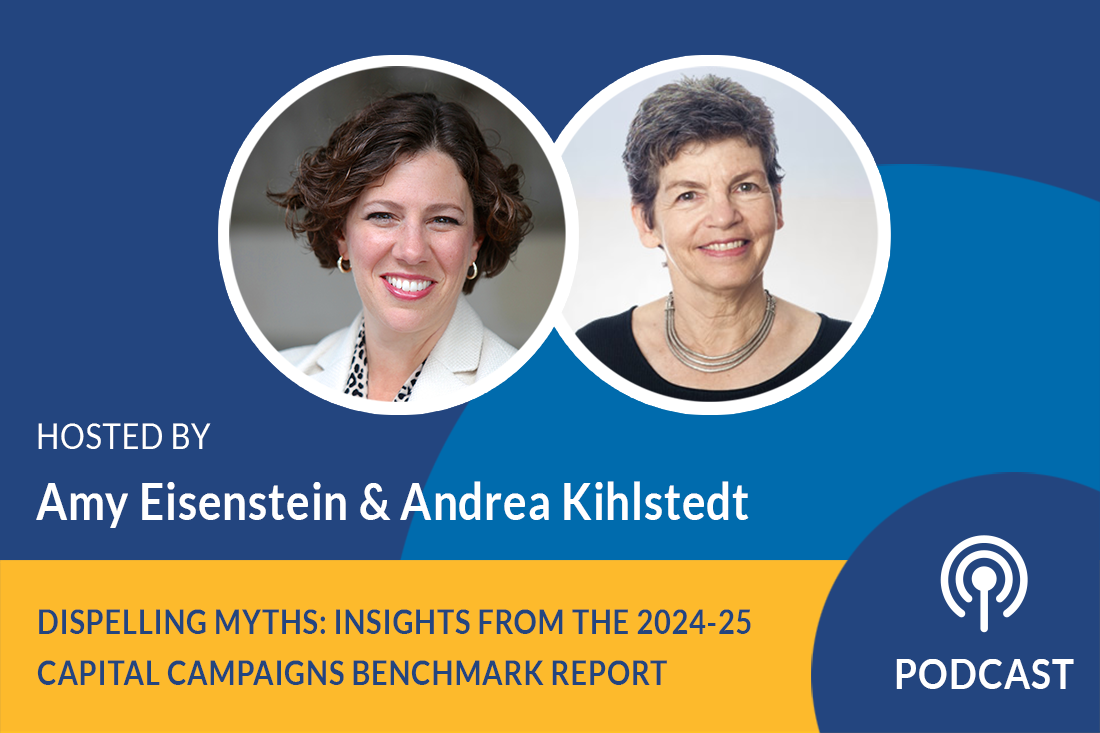Podcast: Five Signs Your Organization Isn’t Ready for a Capital Campaign Yet

Season 3, Episode 47
In this episode, hosts Amy Eisenstein and Andrea Kihlstedt delve into the crucial indicators that your organization might not be prepared for a capital campaign. From lacking a clear vision to insufficient fundraising staff and history, they outline five telltale signs that necessitate strategic planning and preparation before embarking on such a significant fundraising endeavor.
With insightful anecdotes and practical advice, Amy and Andrea offer guidance on how to assess your organization’s readiness and take actionable steps to ensure a successful campaign in the future.
Listen Now:
Amy Eisenstein:
You may not be ready for a campaign. We’re going to tell you five telltale signs. Hi, I’m Amy Eisenstein. I’m here with my co-founder and colleague, Andrea Kihlstedt. And today, we are talking about five telltale signs that your organization is not ready for a capital campaign.
I think it’s a pretty common thing to wonder if you’re ready. And Andrea and I have come up with a list of the five probably biggest reasons or most obvious reasons, they’re obvious to us, they may not be obvious to you or your board members of whether you are ready or not.
So Andrea, kick us off. What do organizations need to think about?
5 Signs You’re Not Yet Ready for a Capital Campaign
Andrea Kihlstedt:
Amy, I think this is such an important topic because it’s very easy to think:
“Oh, well, we’re just going to do a capital campaign.”
[You] have this magical thinking. A little bit of magical thinking is fine. But really, there are some things you should watch out for. We’re going to give you these five tips and maybe the word we should add to all of them is yet. You may not be ready for a capital campaign yet.
Amy Eisenstein:
I love that.
Andrea Kihlstedt:
Any of these five tips apply to you, understand that you can work on all of these. You can build them over time. It doesn’t mean that you’ll never be ready for a campaign, but perhaps that you’re not ready yet.
Amy Eisenstein:
I just looked at the list to make sure I’m like, “Oh yeah, that’s true.”
Andrea Kihlstedt:
Is that true? Oh, good.
Amy Eisenstein:
Everybody can get ready for all of these things.
Andrea Kihlstedt:
Good. Good. So we can apply yet, the yet test. Right?
Amy Eisenstein:
Right. You may not be ready yet. But then, good, so you’ll take action steps to get ready for all of these things if you’re not ready yet.
Okay, what’s number one?
1. You don’t have a big, bold vision.
Andrea Kihlstedt:
Number one is this: you or your organization does not have a big idea around which to raise money. Capital campaigns are based on something exciting, on something specific. It’s not just that we want more money. You have to want more money to do something that is going to move your organization forward to have a successful campaign. And if you and your board or your executive director are just wanting to raise more money for nothing ’cause you want some more money, right?
Amy Eisenstein:
Because it’s your anniversary.
Andrea Kihlstedt:
Yes, exactly.
Amy Eisenstein:
We hear that all the time. It’s our 50th anniversary, so we want to raise $50 million. Well, you know what? Not too many people except for your immediate circle care that it’s your 50th anniversary, and they’re certainly not going to dig deep to give you $50 million. The idea needs to be much more exciting than that. And the fact that you just want more money or need more money for your annual fund, that is not a reason enough to have a capital campaign.
Andrea Kihlstedt:
So let’s add the yet to that. So what that would say to me is that you and your board should really spend some time saying:
“Well, what would move us forward? What should we be doing to move this organization ahead so that we can do more for the people that we serve or to carry out our mission more fully?”
Let’s figure that out.
Amy Eisenstein:
Right.
Andrea Kihlstedt:
So you’re not ready yet because you don’t know the answer to that yet.
Amy Eisenstein:
Right. So it’s time for strategic planning, some blue sky thinking. What is going to catapult our organization for the next 50 years so that we serve our community in a bigger, better, more impactful way?
All right, excellent.
2. You don’t have at least 10 big donors.
Number two on the list is you need to be able to make a list of 10 of your leadership level potential biggest donors. So you need to make a list of at least 10 people who are six and seven figure prospects. Those that are going to give you $100,000 gifts, half a million-dollar gifts and $1 million dollar gifts. If you can’t make a list like that, you’re not ready yet.
Andrea Kihlstedt:
And that’s for a significant capital campaign. Of course, you can scale down those numbers if you’re talking about a little campaign. And you can do a little campaign, let’s say for a half a million dollars or a quarter of a million dollars, you can do that and then the numbers would be smaller.
Nonetheless, you would need to be able to identify 10 donors who could give you the top gifts relative to the campaign size that you’re taking on. And if we say to you, “Okay, can you make a list of those top 10 donors?” And you all feel yourself getting scared. And you look at the piece of paper and it’s blank, then guess what? You are not ready yet.
Amy Eisenstein:
Yes. Although I have to say, I do ask this question frequently when I’m talking to prospective clients and I ask them if they can make a list like this, if they have any sense of who their lead donors might be, who would give a 20% of their campaign goal, 10% of their campaign goal.
And just because you can’t make it sort of instantly or off the top of your head, doesn’t mean that after a meeting or two, taking a deep dive into your database, talking to some of your key board members, talking to three or four people, you couldn’t come up with a list.
So this may be way out of reach. It may be months or years away. Or it just may be days or weeks away if you’ve never thought about it that way before. So yet is relative, right? It just may take a little research, or it may take a lot of work.
Andrea Kihlstedt:
Right. That said, Amy, the organizations that are really doing a good job of fundraising know who their top donors are.
Amy Eisenstein:
It’s true.
Andrea Kihlstedt:
They don’t have to go and look in their database and say, “Well, maybe so-and-so has money.” They already know who their top donors are and they’re paying attention to those top donors. Year in and year out, they’re paying attention to them.
Amy Eisenstein:
Yes.
Andrea Kihlstedt:
So to be really ready —
Amy Eisenstein:
You’re right.
Andrea Kihlstedt:
… you should know who they are. Now, to be ready, you sort of know who they are, and you’ve got some work to do to build those relationships.
Amy Eisenstein:
Right.
Andrea Kihlstedt:
And if you’re really not ready in this, then you’ve got even more work to do to find out who in your community, those donors might be and to bring them on. So that’s an important part of the work. And if you do that work, it will not only lead you to a capital campaign, but it’s going to strengthen your regular fundraising.
Amy Eisenstein:
Yeah, absolutely. You’re right. Everybody should be able to rattle off the top three, five, seven names.
Andrea Kihlstedt:
Right.
Amy Eisenstein:
When I push them to think about 20 names and so that takes a little more thought.
Andrea Kihlstedt:
Yes, yes.
Amy Eisenstein:
Five to ten —
Andrea Kihlstedt:
It’s five or ten.
Amy Eisenstein:
Yes.
Andrea Kihlstedt:
Everybody should know who their top five or 10 donors.
Amy Eisenstein:
You should know who those are. Yes, absolutely. All right.
Andrea Kihlstedt:
Number three.
Amy Eisenstein:
Yes, go ahead.
3. You don’t have a staff for fundraising.
Andrea Kihlstedt:
So no development staff, no fundraising staff. You are an all-volunteer organization. Now, it turns out that while it’s not impossible to run a capital campaign that way, with no staff at all, it’s really difficult.
Unless one or two of your volunteers are willing to act like staff, are willing to take it on as though they were staff members, even though they’re not getting paid. It happens occasionally, but it’s rare.
So your organization needs to be grown up enough to actually have some real dedicated fundraising staff members to carry out a campaign. This is not chicken feed, it’s not easy. Right? Somebody needs to be well organized, and to set it up properly, and to know something about fundraising to actually get the whole thing managed and effectively run.
Amy Eisenstein:
Yeah. So sometimes that’s just an executive director if there’s no other fundraising staff. But ideally, you have a development director at least and are considering also staffing up for a campaign. If you’re running a campaign of more than a million dollars, you probably need to add a staff member. It might be a campaign manager, it might be an administrative assistant. It might be outsourcing some of the other development responsibilities like hiring a part-time grant writer, or a grant writing consultant, or somebody to help with events.
So there’s lots of ways to think about staffing up, but your existing staff can’t do everything that they’ve already been doing plus a capital campaign on top of it without additional support and expertise. So really, thinking about who’s going to do the work of the campaign? And it’s likely existing staff and they need support. But really, the number three is if you don’t have fundraising staff, you’re not ready for a campaign yet.
4. You don’t have a history of fundraising.
Andrea Kihlstedt:
Good. Let’s go to number four, Amy. And that is that you have no history of fundraising. And then of course, goes with not having any fundraising staff. If you have no history of fundraising and you’ve been operating, maybe somebody gave you a big grant. Maybe you’ve just been sort of bootstrapping along to get the work done, and that’s not to discourage you from doing that.
I mean, I got to say I’m a huge fan of people who just go out and get things done, make a big difference in the world. I’m a huge fan of that. But if you’re going to have a capital campaign, you really do need to have some history of fundraising. You need some practices and systems in place. You need to built a donning relationship, a giving relationship with people over time, so they’ve come to trust you and to trust your systems. And they’ve come to think of you as one of the organizations that they support.
If you have no history of that, you probably are not ready for a campaign yet.
Amy Eisenstein:
Yet. Well, let me just tell a quick little story about that.
Some Fundraising Experience is Essential
So I talked to this little animal shelter the other day, and we actually have lots of animal shelters as clients. We love working with animal shelters and humane societies. But I was talking to this little startup one and they really were bootstrapping it. So I have to say lots of respect, but…
- They had no donor database.
- They didn’t track their donors.
- They really didn’t have any systems in place.
- They had almost no donors, or they certainly didn’t know who they were.
- And honestly, they were not ready for a campaign yet.
So I did give them a little checklist of things to do. Which reminds me, if you’re not sure if you’re ready for a campaign, I would love you to head on over to the Capital Campaign Pro website.
4 Campaign Readiness Assessments
We have a readiness assessment in our resources section. Actually, we have four readiness assessments to test your readiness.
- One is a board readiness assessment.
- One is a development office systems and structures.
- One is an overall campaign readiness assessment.
- And the last one is a tech readiness assessment.
Now, if you go over to our resources site and you take these readiness assessments, I don’t want you to freak out. You’re not going to be ready in every area, and that’s okay. That doesn’t mean you’re not ready for a campaign. It just shows you what you need to work on as you’re heading into a campaign. And it helps board members and staff members really understand where your strengths and where you need some work. I don’t want to say weaknesses. I’m avoiding the word “weaknesses.”
Okay. All right. Number five, we’re ready –
Andrea Kihlstedt:
Opportunities, Amy. Opportunities.
Amy Eisenstein:
Opportunities.
Andrea Kihlstedt:
Yes.
Amy Eisenstein:
There you go. What you need to work on? What you’re not ready for yet? These are opportunities. Excellent. All right.
Andrea Kihlstedt:
So our fifth thing. And we’ll go over all five again, don’t panic. If you’re driving and you can’t remember what they are, we’re going to give them to you again. But the fifth thing is that your organization needs money now. Right?
5. You need emergency funding RIGHT NOW.
So I mean, actually, we’re online with somebody yesterday who said:
“Our organization knew. We knew we needed a new roof. We knew we needed to raise some money. We were planning on raising it in the fall and all of a sudden, the roof started leaking like mad. And we need the money now because we have to replace the roof, and we don’t have enough money in the bank to cover those repairs. We need a capital campaign to raise money so we can do the roof next month.”
Guess what?
Amy Eisenstein:
Well, I mean, listen, our advice was to go to five donors and ask them to cover it. But you wouldn’t be able to plan a whole capital campaign around emergency fundraising. Now, some emergency fundraising like that.
It’s a compelling case, people understand it. Five or 10 donors can probably cover it. Your biggest donors, you can do a little fundraising outreach. But a real massive campaign, that wasn’t their whole project.
So take care of that immediate need first, but then plan a campaign thoughtfully so that your most campaigns are not done quickly. This is not rushed fundraising. The other question we got yesterday on one of our calls was about not having enough money in the bank for payroll. That is not a capital campaign either.
Andrea Kihlstedt:
Right.
Amy Eisenstein:
Right?
Andrea Kihlstedt:
Right.
Amy Eisenstein:
You need emergency fundraising? No, no, no.
Andrea Kihlstedt:
Right.
Amy Eisenstein:
That is not for a capital campaign. A campaign is planful, thoughtful, it’s strategic, it’s a process. It’s about engaging donors in a big meaningful way. When you rush fundraising, you get small gifts, or you get no gifts.
Andrea Kihlstedt:
And successful campaigns are really based on organizations that are strong, not organizations that are weak. Right? Capital campaigns that try to fill in weaknesses tend not to be successful. Capital campaigns that are based on a strong organization that wants to grow and do more tend to be successful. And that, of course, takes some time.
Review: 5 Signs You’re Not Ready for a Capital Campaign
So Amy, let us review our five sort of yellow flags, reasons that you may not yet be ready for a capital campaign. And we really encourage you to pay close attention to all five of these.
Amy Eisenstein:
Excellent.
Andrea Kihlstedt:
So are you ready?
Amy Eisenstein:
Yes.
Andrea Kihlstedt:
Amy, what’s the first one?
Amy Eisenstein:
Number one, you just need to raise money. You don’t have a big specific clear idea, you just want more money. So you’re not ready for a campaign yet. Number two, go ahead.
Andrea Kihlstedt:
You can’t identify the top five or 10 donors. Not ready for a campaign yet.
Amy Eisenstein:
Yes. Number three, you don’t have any fundraising staff. You don’t have staff who’s going to do the work of the campaign. You’re not ready for a campaign yet. Okay, number four.
Andrea Kihlstedt:
Number four, no history of fundraising. You’ve been scrapping it together and doing a great job of that, but you don’t have any real fundraising program. That probably means you’re really not ready for a capital campaign yet.
Amy Eisenstein:
Yeah, you don’t have any donors. You don’t have a donor base.
Andrea Kihlstedt:
No donors, no systems, no practices, no people who are sophisticated in fundraising. Not yet.
Amy Eisenstein:
All right. And number five is not enough timeline, right? Emergency needs, too short of a turnaround. Does that not bode well for a capital campaign. So excellent.
So head on over to the Capital Campaign Pro website to grab your readiness assessments, they’re under the resources tab. And thank you for joining us and we’ll see you next time.



Leave a Comment